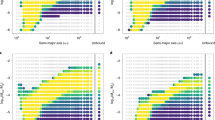Play all audios:

Possible planetary objects have now been discovered1–9 orbiting nine different main-sequence stars. These companion objects (some of which might actually be brown dwarfs) all have a mass at
least half that of Jupiter, and are therefore unlikely to be hospitable to Earth-like life: jovian planets and brown dwarfs support neither a solid nor a liquid surface near which organisms
might dwell. Here we argue that rocky moons orbiting these companions could be habitable if the planet–moon system orbits the parent star within the so-called 'habitable zone'10, where
life-supporting liquid water11 could be present. The companions to the stars 16 Cygni B and 47 Ursae Majoris might satisfy this criterion. Such a moon would, however, need to be large enough
(>0.12 Earth masses) to retain a substantial and long-lived atmosphere, and would also need to possess a strong magnetic field in order to prevent its atmosphere from being sputtered away
by the constant bombardment of energetic ions from the planet's magnetosphere.
Anyone you share the following link with will be able to read this content:
